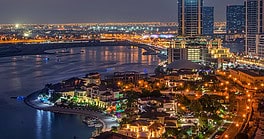Challenges like climate change are raising demand for subsidies, despite the threat of enlarged debt burdens.
Being stuck behind a Guatemala City bus belching out lead can test the patience of the most sanguine driver. Transport subsidies dating back to the 1970s have surpassed $2.2 billion in the Central American country’s capital. They remain in place without evidence they are effective, thanks in part to the associations that receive those subsidies having pressured the government through strikes, road blockages, and violence.
Today, subsidies of various kinds are coming into question across the world just as multinational lenders are pushing to shift grants, loans and subsidies away from fossil fuels and toward sustainable energy investments. But getting the two trends to dovetail is proving difficult. Attempts by Guatemala to modernize its mass transportation system, for example, are hampered by lack of investment in new vehicles and by grants that cover only the capital city.
“The power of the urban transport businesses was very strong and had the logic of the rich kid, owner of the neighborhood ball: If I don’t like the game, I take the ball and go home,” says Eduardo Velásquez Carrera, professor at the University of San Carlos in Guatemala City. “So, every time there was an initiative to adjust transport fares, and the municipality did not agree, they took the buses out of circulation.”
Fifteen-minute cities (an urban-planning concept in which no one must travel more than 15 minutes by bicycle or on foot to reach essential services) and extensive mass transport grids are the ideal. But they are a far cry from the urban sprawl of Guatemala, where the capital city has metastasized to consume numerous nearby satellite cities. At least four million people now make a minimum of two journeys a day within the capital, averaging under 10 mph for a two- to three-hour journey in each direction, according to Velásquez’s research.
New President Bernardo Arévalo has promised an inaugural metro system by 2026; but for the project to succeed, subsidies must be better targeted, and long-running engineering and urban-planning problems must be overcome.
Both the International Monetary Fund (IMF) and the World Bank began 2024 with major changes to their loan programs. World Bank President Ajay Banga, who assumed office in June, wants to diversify into more-sustainable alternatives.
“To focus on changing and fighting climate change, estimates are all in trillions,” he said in a November interview with The Banker. “There are pools of money out there—in [multilateral development banks], government coffers, the private sector and philanthropies—and we should exploit those. But there are other pools as well, such as the $1.25 trillion a year that goes into subsidies for fossil fuel, agriculture and fisheries. While not all of it is wasted, the World Bank estimates that $6 trillion every year is the cost of the environmental damage from that $1.25 trillion.”
At the recent World Economic Forum meeting in Davos, Switzerland, IMF Managing Director Kristalina Georgieva stated that $7 trillion in fossil fuel subsidies needs to be shifted to help fight climate change, equivalent to 6.4% of global GDP. East Asia and the Pacific amount to almost half of this global subsidy, with Iran the largest fuel subsidizer.
Achieving that realignment will not be simple, however. “There are some necessary subsidies,” Velásquez argues. “If you give the subsidy to the person who is using the public transport system, then it is an incentive for the system to improve. In Guatemala, the other big problem is that the municipalities don’t know about how the infrastructure could be built. They don’t have underground maps or maps of the sewage network.”
Debt: The Complicating Factor
Some Caribbean countries face dual issues of access to subsidies and debt overhang, further complicating the adoption of climate-friendly measures. According to the Inter-American Development Bank, the Caribbean region’s average debt-to-GDP ratio rose from 75% in 2019 to 99% in 2020, although it is estimated to have fallen back to 77% by the end of last year. Debt rose during the pandemic and the recovery. As of the start of 2023, total debt had risen in Latin America and the Caribbean to $5.8 trillion, or 117% of GDP, from under $3 trillion in 2008.
Jamaica has been working to trim its debt load in the aftermath of Covid-19.
“Having spent about 2% of GDP on a fiscal incentive package, the question now becomes, what is the nature of local inflation? I have not seen any empirical data that links incentives during the pandemic to inflation,” says Richardo Williams, assistant vice president of Investment Strategy and Portfolio Advisory at Barita Investments in Kingston.
Jamaica’s debt-to-GDP ratio plummeted from 109.7% in 2020 to 72.3% in 2023, backed by homegrown solutions and adherence to an IMF program from 2013. That program includes removal of individual ministries’ discretionary subsidies, which are now centralized under the finance ministry. This was solidified in the 2017 Financial Administration and Audit Act, which added budgetary oversight to prevent revenue leakage.
But if the Caribbean continues to see high debt or inflationary pressures, where will it find the resources to fight climate shocks in a region prone to unpredictable weather events? Hurricanes Jeanne (2004), Katrina (2005), and Maria (2017) left over 7,800 dead and more than $229 billion in damage in their wake, according to estimates.
“You will see the nonbank institutions accounting for a larger share of credit in the economy as opposed to bank loans proper,” says Williams. “Based on the latest data coming out of the financial services commission, there’s a real incentive to fund the real economy. The credit-to-asset ratio is now about 30%. The regulatory minimum is 10%, so you have a lot of capital there, really.”
Public-private partnerships and nonbank financial institutions will play a major part in the Caribbean’s clean-energy future if public and private sectors cannot, especially regarding new technologies such as electric vehicle charging points. Sensing a shift, Jamaican financial institutions are expanding beyond their national borders, as alternative investment manager Sygnus expanded into Puerto Rico last year. NCB Financial Group had acquired majority control of Trinidad and Tobago’s Guardian Holdings earlier, in 2019. More cross-border financial collaboration can be expected in the form of deals that can then be syndicated for local or regional climate-resilient and mega-infrastructure projects, some of them implementing the multilateral institutions’ push to diversify away from fossil fuel subsidies.
Getting Creative
Innovative deal structures could have a role to play as well.
“Do we do something like a debt-for-nature swap: for example, shaving off 10% of our [debt-to-GDP ratio] if we are able to maintain forestry cover?” Williams asks. “I see the region being in the vanguard when it comes to the matters of adaptation, resilience, climate change, etc. I’m sure subsidies will be part of that.”
That said, he expects the region will “always be in a catching-up position relative to the world, just because we don’t have the fiscal space to invest in the same quantum and pace as other global economies.”
Multilaterals could play a more critical role in deals involving blended finance and first-loss capital. In the latter, the first tranche of capital in the overall structure absorbs any loss, adding a risk management element that makes it easier to attract investors to innovative products. Elements of first-loss capital can be seen in the Green Climate Fund, the EU’s Global Gateway system, and Barbados’ Bridgetown Initiative.
Selling carbon credits is already earning 15 countries an income from preserving forests. Indonesia is repurposing mangrove plantations and committed to restoring 600,000 hectares to create a 60 million tonne (about 66 million US ton) carbon sink over the next couple of decades. The Democratic Republic of Congo, Ghana and Mozambique are also expanding their carbon-credit projects.
According to the World Bank’s International Debt Report 2023, developing countries spent $443.5 billion servicing external public debt in 2022, 5% more than the previous year. Chad, Ethiopia, Ghana and Zambia received $12 billion in funding over the past three years through the G20’s Common Framework for debt treatment, half in grants and the rest in concessional loans. Should these prove successful, similar deals could be rolled out to other countries to help stimulate economic growth and fight climate change.
Subsidies, it seems, are not going away. They are being adapted to combat current, targeted issues like climate change. But the balancing act of public finance is one Latin America and the Caribbean will need to correct first, most likely through a combination of homegrown solutions, multilateral support, creative financing—and subsidies.




